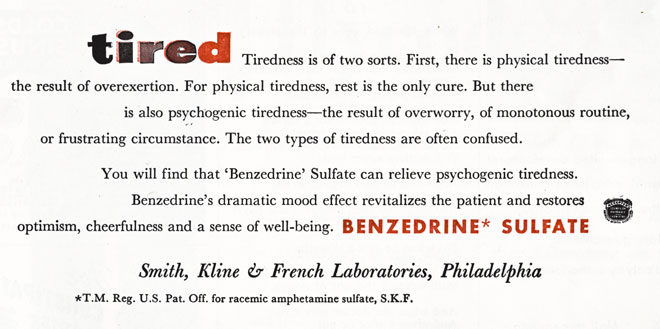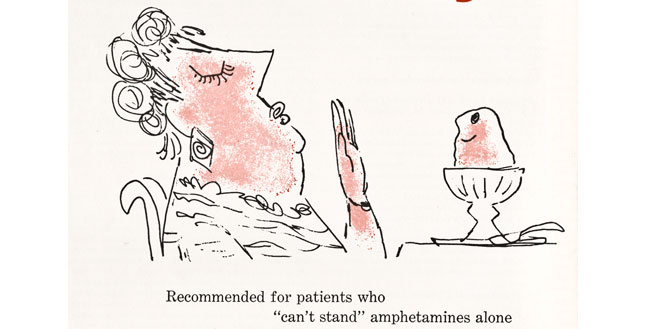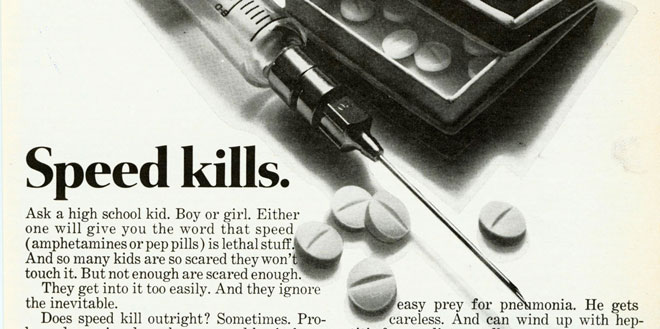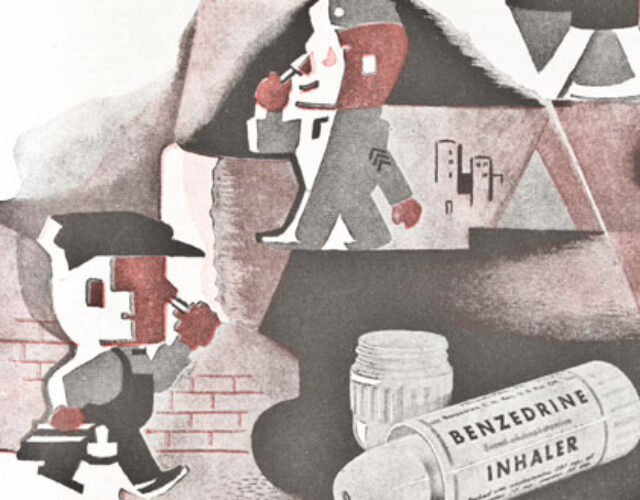Gordon Alles thought he was testing a new asthma medicine. The Los Angeles chemist had tried without success to improve on ephedrine, the decongestant and bronchodilator that had in recent years become a blockbuster asthma, cold, and allergy treatment for drug maker Eli Lilly. Alles began to focus on a compound he called beta-phenyl-isopropylamine. He didn’t know it at the time, but the drug had been first synthesized in 1887 by Romanian chemist Lazar Edeleanu. For over 40 years chemists had considered it pharmaceutically valueless, but Alles was about to prove them wrong, discovering what became the first psychoactive prescription drug—and igniting a decades-long controversy.
On June 3, 1929, a doctor injected 50 milligrams of amphetamine into Alles’s body. In the early days of scientific drug discovery researchers routinely experimented on themselves. In addition to feeling they had a moral duty to future test subjects, they believed their training and familiarity with a compound made them the best observers of its effects. In this case Alles had tested his compound on guinea pigs, though he couldn’t know exactly what to expect when he became his own guinea pig. He took what he estimated was a nonlethal dose—five times greater than later recommendations—and prepared himself. If amphetamine worked as he hoped, he’d have a lucrative, patent-protected drug that could go head-to-head with ephedrine.
Seven minutes later he sniffed: his nose was dry and clear. His blood pressure climbed dramatically. After 17 minutes he noted heart palpitations but also a “feeling of well being.” He grew chatty and at a dinner party that night considered himself unusually witty. Some eight hours after taking the drug his blood pressure had nearly returned to normal. Still, he recorded, “Rather sleepless night. Mind seemed to run from one subject to another.”
Similar effects characterize a group of drugs now known as amphetamines, as Alles later named them. Bolstered by apparent success, he began testing with actual patients. He gave an asthma sufferer 20 milligrams by mouth; two hours later she was still wheezing, despite feelings of euphoria. The next week a 50-milligram shot relieved her asthma attack but left her nauseated and headache-stricken. As an asthma treatment, the chemical seemed to have no future.

But Alles saw potential in a euphoria-producing stimulant—even one lacking any obvious medical application. He began sharing the drug with a small, informal group of doctors and researchers for experimental use. It might help keep narcoleptics awake. Perhaps it could be used as a heart stimulant or for relief from menstrual pain. In the meantime Alles protected his intellectual property: a 1932 U.S. patent declared him the inventor of amphetamine sulfate and amphetamine hydrochloride. It also recognized him as the discoverer of their medicinal value, a common second claim in the realm of drug law. If for some reason Alles couldn’t defend his claim to have invented the compounds (Edeleanu had preceded him), he still had a patented claim on their use as medicine.
Even with his patent in hand developing the drug would require greater resources than Alles possessed. He approached Philadelphia pharmaceutical firm Smith, Kline, and French (SKF) about a partnership. The company already produced one amphetamine product, the Benzedrine inhaler, patented almost simultaneously with Alles’s compounds. The large, established company was still getting its bearings in the new era of drug development and needed young scientists like Alles. They agreed to royalty payments, a salary, and lab space. SKF would get a first look at anything the chemist produced. In exchange SKF would devote its considerable marketing muscle to transforming amphetamine from an experimental compound into a “wonder drug.”
The plan succeeded. By the late 1930s college students used “pep pills” to increase their productivity. Amphetamine fueled American soldiers marching into World War II, served as the chatty muse to famous 1950s Beatniks, and worked as a “little helper” for disappointed 1960s housewives. It was the chemical copilot for long-haul truckers and the “speed” that roiled the Flower Children. Amphetamine and its variants would be hailed as medical miracles, then demonized as an addictive, life-destroying social scourge. But once Alles and SKF brought amphetamines into public consciousness, they never truly went away: the crystal meth and Ritalin of today are essentially the same drugs used (and abused) 70 years ago.
Amphetamine fueled American soldiers marching into World War II, served as the chatty muse to famous 1950s Beatniks, and worked as a ‘little helper’ for disappointed 1960s housewives.
The story of amphetamine—its rise, fall, and inevitable return—is the story of the first psychoactive prescription drug, a drug valued almost entirely for its mood-altering effects. It began a new era of pharmaceuticals, and we are still working through the consequences today.
From Chemical to Medicine
In December 1934, SKF purchased the rights to Alles’s amphetamine. But along with the purchase came the question of what the drug was actually good for. This was still the era of patent medicines, a time when newspaper ads hawked dubious cure-alls made from unspecified ingredients. These activities were all perfectly legal: with virtually no government oversight SKF could sell its new product without testing it beforehand. But getting word out to doctors meant advertising in medical journals, which required permission from the American Medical Association (AMA). And to gain the AMA’s imprimatur, a drug had to be proven both safe and effective, which meant commissioning studies that could persuade the AMA Council on Pharmacy, an august body of doctors and scientists.
That said, safety studies were a relative formality. Animal testing helped establish a safe dosage range and revealed any obvious harm at high doses. With this information in hand researchers could move on to human testing, further refining the drug’s application and looking for side effects. But many of the long-term questions we would expect to be addressed today—about the possibility of addiction, for example—went unanswered. A University of Pennsylvania study SKF used to prove amphetamine’s safety focused mainly on its blood- pressure effects. The drug demonstrated no apparent ill effects, and the research later appeared in the highly regarded American Journal of Medical Science. That was proof enough for the AMA: amphetamine’s safety stood confirmed.
The question of effectiveness, however, was of a subtly different kind. Eli Lilly’s asthma and cold medicines were already successful, and SKF’s Benzedrine inhaler aimed at roughly the same market. But amphetamine worked no better than ephedrine in that capacity; indeed, it was arguably worse. Without the cold-treatment option, SKF wanted another large market. So the effectiveness question had an implied addendum: what problem does amphetamine effectively treat in a profitable way?
Amphetamine kept narcoleptics awake and seemed to quell the tremors of Parkinson’s sufferers, but patient numbers in these groups were too small to create a profitable market. Both afflictions have a biological basis in the nervous system, and so it made sense to treat them with a nervous-system stimulant. SKF, though, chose to exploit the more subjective effect of amphetamine—what Alles had called the “feeling of well being.”
In early 1937 the new drug debuted: Benzedrine Sulfate, which evoked a positive association with SKF’s own inhaler brand. This new version was a pill, though, and no simple cold medicine. In a mailing sent to 90,000 doctors (almost the entire AMA membership) SKF declared “the main field for Benzedrine Sulfate will be its use in improving mood.”
Meanwhile, several clinical studies had shown that amphetamine had little effect on severe depression, anxiety, or schizophrenia. In fact, it often exacerbated the last two: a revealing finding that became significant only later, when physicians began to see cases of “amphetamine psychosis.” Amphetamine did, however, help cases of mild depression, which fit SKF’s plan to emphasize the drug’s mood-altering effects. In December 1937 the AMA Council on Pharmacy granted permission to advertise the drug as a new treatment for narcolepsy, Parkinson’s, and mild depression. Benzedrine Sulfate had become the first prescription anti-depressant, and SKF’s marketing began in earnest.
The earliest ads appeared in the Journal of the American Medical Association, helpfully defining “The Patient with Mild Depression.” Symptoms included
Below this list the company placed a small black-and-white photo of its “Benzedrine Sulfate Tablets,” recommended for their “striking effect upon mood,” such as “a sense of increased energy, mental alertness, and capacity for work.” Aimed at doctors, the ad emphasizes the patient’s subjective feelings of ill health in expansive ways. “If taken seriously,” Nicolas Rasmussen notes in On Speed: The Many Lives of Amphetamine, “this last criterion would hugely increase the number of diagnosed mild depressions to include large numbers of patients in general practice: a third or more of patient visits to the family doctor were (and still are) just like this, complaints lacking an apparent ‘organic basis.’”

This potential for overprescribing appears obvious in hindsight. It may also have occurred from the beginning: in 1938, the first full year of advertising, sales jumped from $95,000 to $175,000. The next year, thanks in part to more ads targeting depression, that number nearly doubled, to $300,000. Buoyed by studies carried out by supportive researchers, amphetamine gained a reputation for safety and effectiveness. “One of the fundamental drugs in medicine,” SKF’s advertising declared, with physicians and the public inclined to agree. Benzedrine Sulfate—the first prescription drug for treating “discouragement”—was on the way to medical stardom.
From Medicine to Disease
Almost from its beginning, though, amphetamine was ripe for nonmedicinal use. From its introduction in 1931 to the end of 1938 SKF claimed to have shipped over 10 million Benzedrine inhalers. Others quickly realized the opportunity to sell inhalers containing similar, unpatented stimulants—such as methamphetamine or mephentermine, a cardiac stimulant. And some users quickly realized the ease with which they could crack open inhalers to consume the drugs inside. Until 1959, when the Food and Drug Administration banned them, these inhalers offered a cheap, legal high, inducting Beatnik luminaries like Jack Kerouac and Allen Ginsberg into the habit.
Kerouac, especially, claimed the amphetamine buzz improved his writing by shearing away his conventional view of the world. He likened it to jazz, the way it produced in him a spontaneous, improvised, propulsive prose. He was so enamored of the drug’s effect on his mind that he used it until his hairline receded and his legs swelled up due to thrombophlebitis. (It’s unlikely that amphetamine directly caused the ailments, but rather Kerouac’s tendency to use it intensely, taking high doses and writing at his desk for hours without food or sleep.) Ginsberg had a similar perspective, using Benzedrine to explore his consciousness. For them Alles’s noted “feeling of well being” had profound, almost mystical importance. Amphetamine was not just a medicine—to return the ill to sprightly good health—but an enhancement, a way to make average people better.
The inhaler method, though, appealed to only a minority of recreational amphetamine users. Alles’s Benzedrine Sulfate pills had already come to market, offered in a more precise dosage while being nearly as easy to procure. In 1936 researchers at the University of Minnesota had given pills to student volunteers in order to evaluate any psychological effects. The participants realized they could use it to stay awake and study harder; in fact, SKF had considered marketing the drug as a study aid. But when articles about student misuse appeared in Time and the New York Times in early 1937, the company quickly responded to quash the negative publicity. Amphetamine was never officially marketed as a study or concentration aid (its effects as such are dubious), but its off-label use continued. Like the later Beatniks, the student self-medicators used amphetamine to “enhance” their capacities.
But the greatest experiment in amphetamine-based enhancement came in World War II. In 1939 the Blitzkrieg’s success was attributed partly to the use of Pervitin—methamphetamine—among German soldiers. By mid-1940 the British and American militaries had begun their own respective chemical investigations. Both eventually settled on Benzedrine to combat fatigue and boost morale. The drug proved especially popular among pilots and air crews, who often had to fly long, grueling bombing raids late into the night. By 1943 a package of Benzedrine pills had its place in the emergency kit of every American bomber. Two years later a survey of European-theater fighter pilots who frequently flew long missions showed that around 15 percent frequently used Benzedrine.
By 1943 a package of Benzedrine pills had its place in the emergency kit of every American bomber.
SKF’s advertising dutifully reported its new use among the country’s fighting force. “For men in combat, when the going gets tough,” one ad began, Benzedrine Sulfate tablets would save lives through “sustaining their mental efficiency by overcoming the symptoms of fatigue.” Here, too, the evidence had proven inconclusive: the pills had slight to no effect on cognitive capabilities, but the “feel-good” effect often made users overestimate their own capabilities. At the same time, the nervous-system stimulation kept soldiers awake past the point of exhaustion, though often with dubious consequences, including hallucinations and paranoia, well-known effects of sleep deprivation and amphetamine use.
Methamphetamine produced similar results; ironically, the accompanying recklessness, along with worries about addiction, quickly led the Germans to discourage its use in the field. American and British forces, however, used amphetamine throughout the war for its effects on mood and morale: it kept up the “fighting spirit.” The British later concluded the subjective boost wasn’t worth the potentially lethal side effects, but the American military continues to use amphetamine to this day, including in the conflicts in Iraq and Afghanistan.
World War II did little to hurt the appetite for amphetamine. In fact, the increased exposure on the battlefield likely helped, and in 1945 SKF produced a million Benzedrine tablets a day. Knock-off artists like Clark & Clark ignored SKF’s patent to produce cheaper, competing pills. Rasmussen conservatively estimates that by the end of 1945 total production averaged about 750 million pills a year: enough for a million Americans to take two pills a day.
Many of those pills went to treat depression, with SKF’s advertisements elucidating a variety of types, including postpartum depression, the depression of the elderly, and depression related to chronic pain. The firm wanted doctors thinking of depression as broadly—and as often—as possible. An advertisement for Dexedrine, the right-handed stereoisomer of the amphetamine molecule, read: “Modern man is a victim of this era. War . . . rumors of war . . . atomic devastation . . . too much government . . . economic uncertainty.” (Allen Ginsberg used the phrase “the atomic disease” to describe both the generalized anxiety around him and, more specifically, amphetamine-induced paranoia.)

The ad offers a prescription not for a specific ailment but for an age. And for nearly three decades the medical community and general public seemed largely agreeable to the diagnosis. Amphetamine’s apparent usefulness just kept expanding. It became a diet pill: overeating, the thinking went, was the physical symptom of a deeper psychological problem. Paired with a barbiturate by SKF, the resulting drug became Dexamyl, another variety of antidepressant and by the 1960s a well-known “upper” among professional athletes.
In 1962 the FDA estimated that eight billion amphetamine pills were being produced every year in America. The pills were impossible to trace, but an epidemic of overprescription seemed obvious. Illicit use was a growing concern, one increasingly difficult to ignore or spin. The mid-1960s brought new social concerns about drug abuse, thanks in part to well-publicized stories from, for example, San Francisco’s Haight-Ashbury district. The counterculture mecca had seen an influx of “speed freaks,” often homeless, who cooked their own bathtub amphetamine. In 1965 Allen Ginsberg turned against amphetamine, declaring, “Speed is anti-social, paranoid making, it’s a drag, bad for your body, bad for your mind.”
Public opinion had begun to shift against amphetamine, with the “speed-freak” stories casting a harsh spotlight on even the more socially acceptable uses of the drug. Evolving science, particularly in Britain, showed the danger of addiction; cases of “amphetamine psychosis” were no longer discounted as coincidence. Rising safety concerns, alongside the emergence of new antidepressants, began to blunt amphetamine’s medical reputation as well. With both the public and the medical community turning against the drug, government action seemed inevitable.
Public opinion had begun to shift against amphetamine, with the “speed-freak” stories casting a harsh spotlight on even the more socially acceptable uses of the drug.
In 1965 the FDA tightened restrictions, requiring more stringent record-keeping by the pharmaceutical industry. This ruling was meant to curb overprescription but proved to be virtually unenforceable. Doctors complicit with their patients’ amphetamine use had little to lose under the new law, and a large grey market still existed. In 1971 the omnibus Controlled Substances Act declared amphetamine a Schedule-II controlled substance—defined as having a high potential for abuse and dependence but with accepted medical use. Once a wonder drug, it was now categorized alongside cocaine, morphine, and opium.
Of course, it never truly went away. Illicit production continued, ramping up again after a brief lull following the government crackdown. Simplified processes for methamphetamine manufacture led to a resurgence in the mid-1980s. The subsequent crystal-meth epidemic has hit rural, western America particularly hard.
Perhaps more remarkable has been amphetamine’s return as a prescription drug. In 1936 psychiatrist Charles Bradley had experimented with a group of learning-disabled boys. Some had specific neurological damage, while others had emotional disturbances. Bradley found that amphetamine, paradoxically, calmed many of the children. SKF never fully exploited this finding, but it underpins the contemporary use of Ritalin and Adderall, both amphetamines. Rasmussen notes that in 2005 the combined pharmaceutical use of these two drugs reached levels similar to the medical use of amphetamine in 1969, just as regulators prepared to crack down.
Amphetamine’s persistence—both as a recreational drug and a medical treatment—suggests an irresolvable dichotomy. As the first drug valued almost entirely for its mood-altering effects, it blurred the line between treatment and enhancement. How important is a subjective “feeling of well being”? When does the lack of such feeling become a medical problem? How should it be treated, and how should society regard those who “abuse” such a drug? Amphetamine was arguably the first drug that forced us to ask these questions. We are still arguing about the answers.




